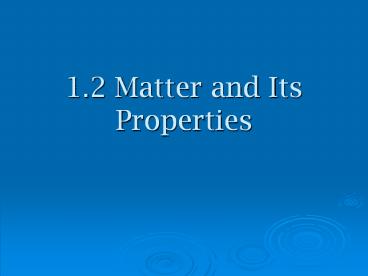1.2 Matter and Its Properties - PowerPoint PPT Presentation
Title:
1.2 Matter and Its Properties
Description:
1.2 Matter and Its Properties ... volume indefinite shape atoms move very quickly atoms are far apart pretty weak attractive forces Changes of State Plasma high ... – PowerPoint PPT presentation
Number of Views:217
Avg rating:3.0/5.0
Title: 1.2 Matter and Its Properties
1
1.2 Matter and Its Properties
2
Terms
- Matter- anything that has mass and volume
- Atom- smallest unit of an element that keeps the
properties of element - Element- pure substance made of only one type of
atom - Compound- substance made of 2 or more types of
atoms that are chemically bonded - Molecule- type of compound in which bonds are
covalent bonds
3
Properties of Matter
- chemists use characteristic properties to tell
substances apart and to separate them - some properties define a group of substances
4
Types of Properties
- Extensive- depend on the amount of matter
- Ex volume, mass, amount of energy
- Intensive- do not depend on the amount
- Ex density, boiling point, ability to conduct
5
Types of Properties
- Physical- characteristics that can be observed or
measured without changing the identity of a
substance - Ex. melting point, boiling pt
- Chemical- relates to a substances ability to
undergo changes that transform it into a
different substance - Easiest to see when a chemical is reacting
6
Physical Changes in Matter
- change in a substance that doesnt change the
identity of the substance - Ex. grinding, cutting, melting, boiling
- Includes all changes of state (physical changes
of a substance from one state to another)
7
Solid
- definite volume
- definite shape
- atoms are packed together in fixed positions
- strong attractive forces between atoms
- only vibrate in place
8
Liquid
- definite volume
- indefinite shape
- atoms are close together
- atoms can overcome attractive forces to flow
9
Gases
- indefinite volume
- indefinite shape
- atoms move very quickly
- atoms are far apart
- pretty weak attractive forces
10
Changes of State
11
Plasma
- high temperature state in which atoms lose their
electrons - Ex. the sun
12
Chemical Changes in Matter
- a change in which a substance is converted into a
different substance - same as chemical reaction
- doesnt change the amount of matter present
- reactants- substances that react
- products- substances that form
13
Energy Changes in Matter
- when any change occurs, energy is always involved
- energy can be in different forms (light, heat,
etc.) - energy is never destroyed or created (law of
conservation of energy)
14
Energy Changes in Matter
- Exothermic Reaction- reaction that gives off
energy (feels warm on outside) - Endothermic Reaction- reaction that uses up
energy (feels cold on outside)
15
Separation Techniques
- Filtration- solid part is trapped by filter paper
and the liquid part runs through the paper - Vaporization- where the liquid portion is
evaporated off to leave solid
16
Separation Techniques
- Decanting- when liquid is poured off after solid
has settled to bottom - Centrifuge- machine that spins a sample very
quickly so that components with different
densities will separate
17
Separation Techniques
- Paper Chromatography- used to separate mixtures
because different parts move quicker on paper
than other
18
1.3 Elements
19
Elements
- elements are pure substances
- organized by properties on periodic table
- each square shows the name and letter symbol for
each element - usually the symbols relate to the English names
but some come from older names (usually Latin) - Ex golds symbol is Au from aurum
- Ex irons symbol is Fe from ferrum
20
Periodic Table
- Groups
- also called families
- vertical columns
- numbered 1?18
- have similar chemical properties
- Periods
- horizontal rows
- properties changes consistently across a period
21
Periodic Table
22
Periodic Table
- two rows below the periodic table are the
lanthanide and actinide series - these rows fit after 57 and 89
- they are only at the bottom to keep the width of
the chart smaller
23
Types of Elements
- Metals
- an element that is a good conductor of
electricity - at room temperature, most are solids
- malleable- can be rolled or hammered into sheets
- ductile- can be made into wire
- high tensile strength- can resist breakage when
pulled - most have silvery or grayish white luster
24
Types of Elements
- Nonmetals
- an element that is a poor conductor of heat and
electricity - many are gases at room temperature
- some are solids usually brittle, not malleable
25
Types of Elements
- Metalloids
- an element that has some characteristics of
metals and nonmetals - appear along staricase line
- B, Si, Ge, As, Sb, Te
- all are solids at room temperature
- less malleable that metals but less brittle than
nonmetals - are semiconductors
26
Types of Elements
- Noble Gases
- generally unreactive gases
- in far right column of periodic table

